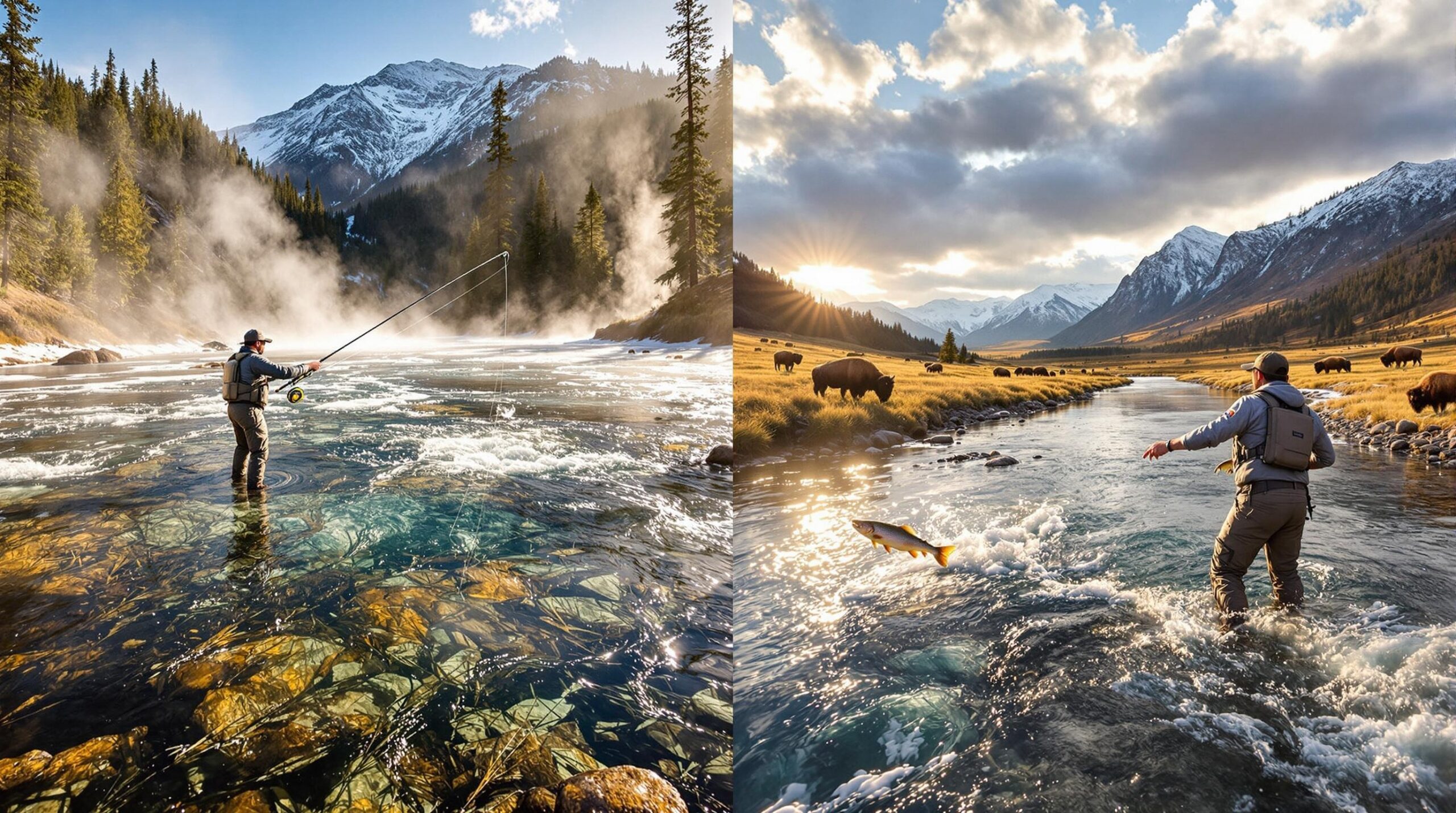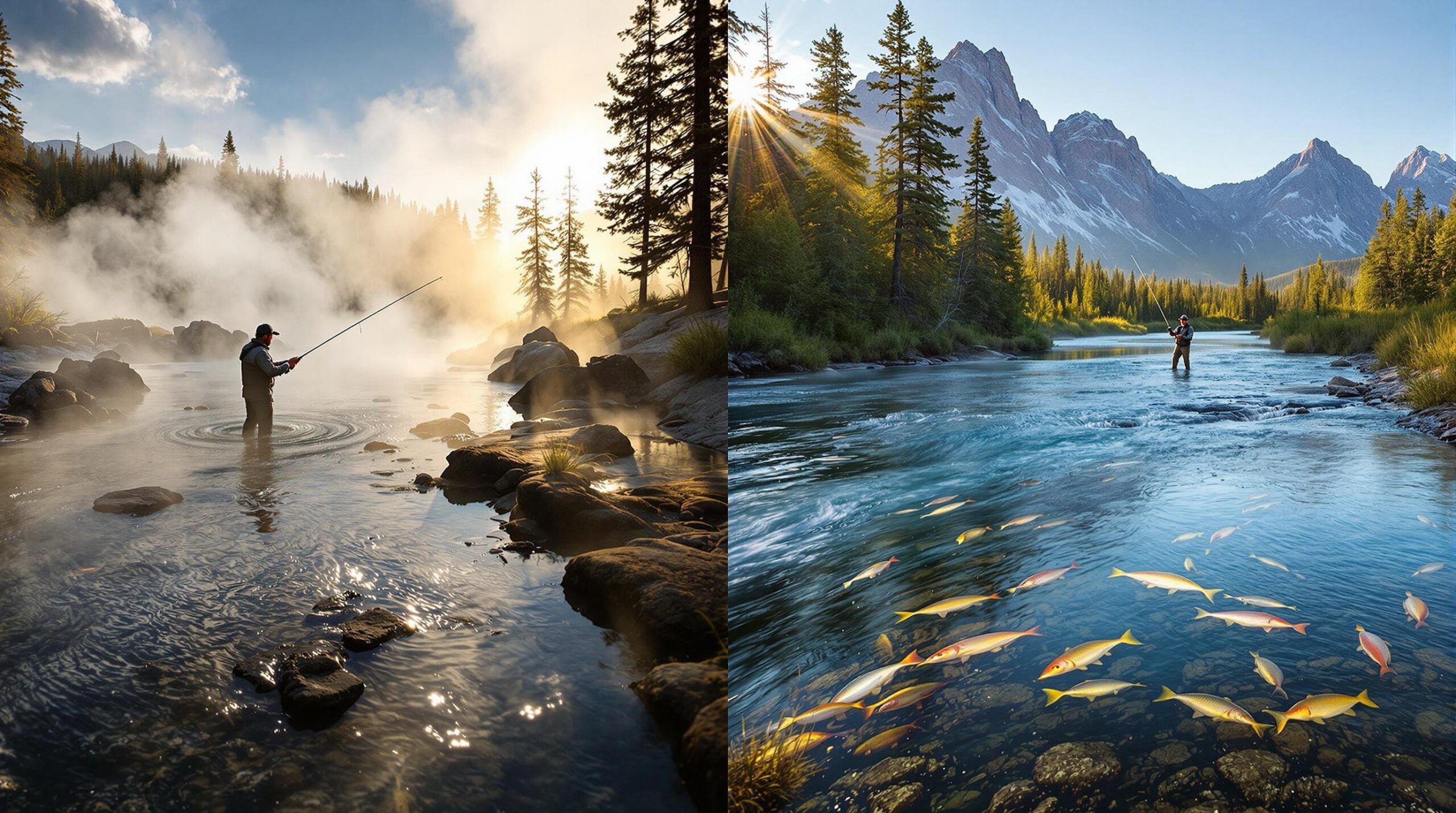According to Yellowstone National Park Service data, the park’s rivers host over 13 different trout species, with the Firehole and Lamar rivers representing two of the most distinct fishing experiences among premier Western destinations. These contrasting waterways offer anglers dramatically different challenges—from thermal-heated waters teeming with brown trout to pristine mountain streams where native cutthroats rise to dry flies in expansive valleys. This remarkable diversity consistently places Yellowstone among the top fly fishing destinations in the world.
Key Takeaways
- Firehole River offers year-round fishing with thermal springs maintaining water temperatures that keep trout active even in winter
- Lamar River provides pristine wilderness experiences with native Yellowstone cutthroat trout in an undeveloped valley setting
- Firehole’s brown trout average 14-16 inches and are notoriously selective, requiring technical presentations
- Lamar’s cutthroats are more aggressive feeders but face seasonal accessibility challenges due to weather conditions
- Both rivers rank among premier fly fishing destinations for different reasons—Firehole for technical challenges, Lamar for scenic beauty
Firehole River: The Technical Challenge
The Firehole River flows for 21 miles through Yellowstone’s geyser basins, creating one of North America’s most unique fishing environments. Thermal springs heat the water to temperatures that rarely drop below 40°F, even during harsh winter months.
This consistent warmth supports exceptional insect populations year-round. Midges, mayflies, and caddisflies emerge throughout winter when other streams remain locked under ice. The abundance of food creates robust brown trout populations, with fish averaging 14-16 inches and some specimens exceeding 20 inches.
Yellowstone fly fishing on the Firehole demands precision. These trout have seen countless flies and become incredibly selective. Standard patterns often fail where innovative fly selections succeed.
Firehole River Fishing Characteristics
The river’s thermal influence creates distinct fishing zones. Upper sections near Old Faithful receive the most thermal input, maintaining temperatures between 60-70°F during summer. Lower sections gradually cool as thermal springs become less frequent.
Water clarity remains excellent despite thermal activity. Visibility often exceeds 10 feet, requiring stealthy approaches and long, accurate casts. The clear water makes these brown trout extremely spooky—sudden movements or heavy footsteps send fish scurrying to cover.
Current patterns change frequently due to thermal springs entering at various points. These temperature gradients create feeding lanes where trout concentrate, but identifying these zones requires local knowledge and careful observation.
Lamar River: Wilderness Fishing at Its Finest
The Lamar River represents everything pristine about mountain trout fishing. This 40-mile waterway flows through Yellowstone’s remote northeast corner, offering anglers an authentic wilderness experience with minimal human impact.
Native Yellowstone cutthroat trout dominate the population here. These fish evolved in these waters over thousands of years, developing unique characteristics that distinguish them from introduced species. Their distinctive red slash marks and aggressive feeding behavior make them favorites among Wyoming fly fishing enthusiasts.
The Lamar Valley setting provides dramatic backdrops for fishing adventures. Bison herds graze nearby meadows while elk and wolves complete the ecosystem. This untamed environment creates fishing experiences that transport anglers back to pre-settlement America.
Lamar River Access and Conditions
Road access follows the river for approximately 20 miles, providing numerous fishing opportunities without extensive hiking. However, seasonal closures protect wildlife during critical periods, particularly spring calving and winter survival seasons.
Water levels fluctuate dramatically with snowmelt and seasonal precipitation. Spring runoff can make fishing impossible until late June or early July. Late summer and fall provide optimal conditions, with clear water and active fish preparing for winter.
The river features classic riffle-pool structure with deep undercut banks holding larger trout. Pocket water around boulders and logjams provides excellent habitat, though navigating these areas requires careful wading due to loose substrate and hidden obstacles.
Species Composition: Premier Destinations Compared
Both rivers support distinct trout populations that reflect their unique environments. Understanding these differences helps anglers choose appropriate destinations based on fishing preferences and skill levels.
Firehole River brown trout display remarkable adaptability to thermal conditions. These fish show consistent activity throughout winter months when other streams become dormant. Their diet includes abundant scuds, midges, and terrestrial insects that fall from surrounding thermal areas.
Lamar River cutthroats exhibit classic native trout behavior. They rise aggressively to surface flies during hatches and show less wariness than heavily fished brown trout populations. Their feeding patterns follow natural cycles closely tied to insect emergence and seasonal changes.
Seasonal Fishing Patterns
Temperature differences create contrasting seasonal opportunities between these premier destinations. Firehole River maintains consistent fishing throughout the year, while Lamar River follows traditional mountain stream patterns.
Winter fishing on the Firehole focuses on midge patterns and small nymphs. Thermal areas remain ice-free, allowing continued access when other waters freeze solid. Brown trout continue feeding actively, though they become more selective during stable weather periods.
Lamar River fishing peaks during late summer and early fall. Cutthroat trout feed aggressively preparing for winter, making them more willing to take a variety of fly patterns. Terrestrial patterns work exceptionally well during late summer when grasshoppers and ants become abundant.
Fly Selection Strategies for Success
Success on either river requires understanding specific fly pattern preferences and presentation techniques. Local insect populations and trout feeding behaviors dictate effective fly choices throughout the seasons.
Firehole River brown trout respond to precise imitations of abundant food sources. Midge patterns in sizes 18-22 work year-round, particularly during winter months. Scud patterns in pink and olive colors match the abundant freshwater shrimp populations thriving in thermal conditions.
Innovative patterns often outperform standard choices on the Firehole. Local fly shops develop specialized patterns that incorporate unique materials and color combinations. These “secret weapons” frequently produce fish when conventional patterns fail.
Lamar River cutthroats readily take traditional western fly patterns. Elk Hair Caddis, Parachute Adams, and Royal Wulff patterns work consistently during surface feeding periods. Attractor patterns often outperform exact imitations due to the aggressive nature of native cutthroats.
Presentation Techniques
Each river demands different presentation approaches based on water characteristics and fish behavior. Mastering these techniques separates successful anglers from those who struggle on these challenging waters.
Firehole River fishing requires delicate presentations due to clear water and selective trout. Long leaders, fine tippets, and careful casting approaches prevent spooking fish. Drag-free drifts become critical when fishing to educated brown trout that inspect every fly carefully.
Lamar River presentations can be more aggressive, matching the feeding behavior of native cutthroats. These fish often prefer flies with movement and action rather than perfectly dead-drift presentations. Slight twitches or skates across the surface can trigger explosive strikes.
Access and Regulations: Planning Your Visit
Both rivers fall within Yellowstone National Park boundaries, requiring entrance fees and adherence to specific fishing regulations. Understanding access points and seasonal restrictions helps anglers plan successful trips to these premier destinations.
Firehole River access remains available year-round through park roads, though winter conditions require preparation for extreme weather. Multiple pullouts and established paths provide easy river access without extensive hiking requirements.
The Grand Loop Road follows the Firehole for much of its length, offering numerous fishing opportunities within short walking distances. This accessibility makes it popular among anglers with limited mobility or those preferring easy access to quality fishing.
Seasonal Access Considerations
Yellowstone’s fishing season officially runs from late May through early November, though winter fishing continues on certain waters including portions of the Firehole River. Specific regulations change annually, requiring anglers to check current rules before fishing.
Lamar Valley road closures affect river access during winter months. The Northeast Entrance closes to through traffic, limiting access to cross-country skiing or snowmobiling from other park entrances. Summer access provides excellent fishing opportunities but requires dealing with peak tourist crowds.
Camping reservations become essential during peak seasons for both destinations. Bridge Bay, Grant Village, and other campgrounds provide convenient bases for fishing both rivers, though advance planning becomes critical for summer visits.
Habitat and Ecosystem Differences
The contrasting environments of these rivers create distinctly different fishing experiences that extend beyond simple trout populations. Understanding these ecological differences helps anglers appreciate why each destination deserves recognition among premier fly fishing locations.
Firehole River’s thermal influence creates a unique aquatic ecosystem unlike anywhere else in North America. Hot springs introduce minerals and nutrients that support exceptional insect populations. The constant temperature regime allows year-round biological activity in what would otherwise be a harsh mountain environment.
Geothermal features along the river create stunning fishing backdrops. Anglers cast flies while steam rises from nearby hot springs and geysers erupt in the distance. This otherworldly setting provides fishing experiences that combine angling success with geological wonder.
Lamar River flows through classic Rocky Mountain habitat featuring sagebrush meadows, aspen groves, and coniferous forests. This pristine watershed supports not only excellent trout populations but also serves as critical habitat for Yellowstone’s large mammal populations.
Wildlife Encounters
Both rivers offer opportunities for wildlife viewing that enhance the fishing experience beyond simple angling success. However, these encounters require careful preparation and appropriate safety precautions.
Firehole River fishing occurs in developed areas with established trails and regular human presence. Wildlife encounters typically involve smaller species, though elk and bison occasionally appear near the water. The thermal features create unique microclimates that support diverse bird populations.
Lamar River fishing takes place in prime grizzly bear and wolf habitat. Anglers must carry bear spray and remain constantly alert for wildlife signs. The remote valley setting provides excellent opportunities for wildlife photography between fishing sessions, but requires respect for wild animal behavior and appropriate safety measures.
Water Quality and Environmental Factors
Understanding water chemistry and environmental conditions helps anglers optimize their approaches on these distinctive waters. Each river’s unique characteristics influence everything from insect populations to trout feeding behavior.
Firehole River’s mineral-rich thermal water creates exceptional productivity despite potential concerns about temperature extremes. The constant influx of nutrients from geothermal sources supports abundant invertebrate populations that feed robust trout populations throughout the year.
pH levels in the Firehole remain slightly alkaline due to mineral content from hot springs. This chemistry supports excellent mayfly and caddisfly populations, creating predictable hatches that attract feeding trout to surface positions.
Temperature Management
Thermal influence on the Firehole creates complex temperature patterns that vary by location and season. Upper sections near major geyser basins may reach temperatures approaching stress levels for trout during peak summer conditions, while lower sections moderate to more comfortable ranges.
Experienced anglers target specific thermal zones where temperatures remain optimal for trout activity. These sweet spots often occur where cold tributaries enter the main stem, creating mixing zones that provide ideal conditions for both trout and insects.
Lamar River temperatures follow natural patterns typical of Rocky Mountain streams. Cold water throughout most of the season supports native cutthroat populations while limiting non-native species establishment. This natural temperature regime maintains the ecological integrity that makes Lamar special among premier fly fishing destinations.
Planning Your Fishing Adventure
Success on either river requires careful planning that considers seasonal conditions, access requirements, and personal fishing preferences. Both destinations offer excellent fishing, but their different characteristics suit different angling styles and experience levels.
First-time visitors often find Lamar River more forgiving due to aggressive cutthroat feeding behavior and scenic wilderness setting. The fish respond well to standard fly patterns and less precise presentations, making it ideal for anglers building confidence or introducing newcomers to western fishing.
Advanced anglers frequently prefer Firehole River’s technical challenges and year-round opportunities. The selective brown trout and unique thermal environment provide ongoing learning opportunities that reward skill development and innovative approaches.
Essential Gear Considerations
Both rivers require standard trout fishing equipment, but specific gear choices can significantly impact success rates. Understanding these requirements helps anglers prepare appropriate tackle for each destination.
Firehole River fishing benefits from longer, lighter rods that enable delicate presentations. Nine-foot 4-weight or 5-weight rods provide excellent control for technical situations while maintaining sufficient backbone for larger brown trout. Fine tippets become essential for spooky fish in clear water.
Lamar River fishing accommodates heavier tackle appropriate for aggressive cutthroat behavior and potential wind conditions in the open valley. Eight-and-a-half to nine-foot 5-weight or 6-weight rods handle larger flies and provide adequate power for distance casting when needed.
Frequently Asked Questions
Which river is better for beginner fly anglers?
Lamar River offers more forgiving fishing with aggressive cutthroat trout that readily take standard fly patterns. The fish are less selective than Firehole brown trout, making it ideal for building confidence and developing basic skills.
Can you fish these premier destinations year-round?
Firehole River provides year-round fishing opportunities due to thermal springs keeping water temperatures above freezing. Lamar River fishing is seasonal, typically from late June through October depending on weather conditions.
What fly patterns work best on each river?
Firehole River requires small midge patterns, scuds, and innovative local flies for selective brown trout. Lamar River cutthroats respond well to traditional attractor patterns like Elk Hair Caddis, Royal Wulff, and Parachute Adams.
Are special permits required for these destinations?
Both rivers require standard Yellowstone National Park fishing licenses available at visitor centers, park entrances, and local fishing shops. No special permits are needed beyond the park fishing license and entrance fees.
Which river offers better scenery while fishing?
Lamar River provides classic wilderness mountain scenery with wildlife viewing opportunities in an undeveloped valley setting. Firehole offers unique geothermal features including geysers and hot springs creating otherworldly fishing backdrops.
What’s the best time of year to fish both rivers?
Late summer through early fall provides optimal conditions for both rivers. Firehole fishing remains good year-round, while Lamar River peaks from July through September when water levels stabilize and cutthroat trout feed aggressively.
Sources:
EPA
Fed Fly Fishers
National Park Service
Montana State University
National Park Service
National Park Service
Trout Unlimited
USGS
Wyoming Game and Fish Department
Yellowstone Association


